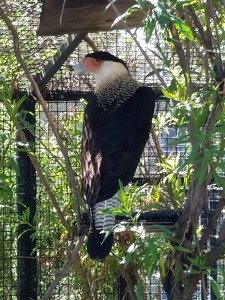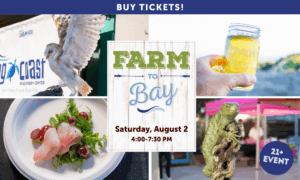By Lindsay Bradshaw, Animal Care Manager
Kuzco came to us from Sky Hunters, a raptor rehabilitation center in Alpine, Calif. He is a Northern crested caracara and the newest member of our avian family here at the Living Coast. He had an injury to one of his wings, making full flight difficult and rendering him non-releasable. Sometimes just called a Northern caracara or crested caracara, these birds actually belong to the falcon family. It can be confusing though, because they look like a long-legged hawk, and behave very much like a vulture, feeding on carrion (dead stuff). These birds are mostly found throughout Mexico, Central America, and northern South America, but have been occasional visitors to the San Diego region. Some birds have actually been filmed and photographed in the Tijuana estuary and Tijuana River Valley. They are commonly seen in southern Texas and Arizona in the United States and are r arely seen in California, but it does happen!
arely seen in California, but it does happen!
TAKING CARE OF KUZCO AND HIS FRIENDS
All the birds at the Living Coast are rescued and non-releasable, sometimes traveling to us from as far away as New York and Georgia! From having different injuries to being imprinted on humans, the birds would be unable to survive in the wild or without human care. We like to think of the Living Coast as a bit of a retirement home for these birds, many of whom are very old. It is a sanctuary for them to live out the rest of their days in comfort, with gourmet rats and mice served every day, and act as ambassadors to their species by providing thousands of people each year with up-close encounters of the “bird” kind.
We get a lot of questions about what we feed our birds here at the Living Coast and if we ever provide them with live food. The answer is no, we do not offer live food. There are some reasons for this, but the main one is that if we put a live mouse in the enclosure, it would just run away before the bird had a chance to catch it. Many of our birds also lack the ability to catch prey, either because they were imprinted at a young age and were never taught how to hunt, or because their injuries prevent them from being able to hunt successfully. Another reason we feed non-live food is because we weigh it out every day so we know how much the birds are eating. This is vital to their health. The last reason we don’t feed live food is because mice and rats have sharp teeth and could fight back, injuring our birds in the process. One reason our birds live so long is because they are kept safe from injuries, which could cause infections leading to illness or even death. Kuzco’s favorite food seems to be a nice big rat, and every now and again, a hardboiled egg.
